Related Research Articles

Auchinleck House is an 18th-century mansion in Scotland. It is situated near the town of Auchinleck near Cumnock and Ayr in East Ayrshire. The Auchinleck Estate has been inhabited since the 13th century, and the remains of Auchinleck Castle and Auchinleck Old House stand in the estate. The house is protected as a category A listed building, while the two ruined dwellings are scheduled monuments.

New Deer is a settlement in Aberdeenshire, North East Scotland, which lies in the valley of Deer. It is located at the junction of several roads crossing through the Howe of Buchan. It was founded after monks from Deer Abbey, Old Deer, built a chapel at Auchreddie, which translates as "field of the bog myrtle", and lies clustered on both sides of the slope of a tributary of South Ugie Water. Around 1507 the register of Deer Abbey lists its lands in the "new paroche of Deir". The name Auchreddie has dropped in significance over the years; however, the southern end of the village is still known by this name.

The Kirk of St Nicholas is a historic church located in the city centre of Aberdeen, Scotland. Up until the dissolution of the congregation on 31 December 2020, it was known as the "Kirk of St Nicholas Uniting". It is also known as "The Mither Kirk" of the city. As of 1 January 2021, the building falls under the care and maintenance of the General Trustees of the Church of Scotland.

Ballumbie is a residential area on the north-east edge of Dundee, Scotland. The area was formerly an estate centred on Ballumbie Castle, a mid-16th-century fortification, which was followed by the 19th-century Ballumbie House. There is also a golf course surrounded by a medieval wall and the site of a late medieval parish church. The castle and house are located just outside the City of Dundee, in Angus.

Tulloch Castle is located in the town of Dingwall in the Highlands of Scotland. It probably dates to the mid 16th century. Over the years, it has served as a family home for members of the Bain family, Clan Davidson, and Vickers family. The castle was used as a hospital after the evacuation of Dunkirk, and then as a hostel for the local education authority. It is currently used as a hotel and conference centre.

Dunglass Castle, situated in West Dunbartonshire on a rocky cliff overlooking the River Clyde, is a 14th-century ruinous castle. It was designated as a Category B listed building in 1971. It has been graded at high risk by the Buildings at Risk Register for Scotland. On its grounds stands the obelisk memorial to Henry Bell, an early steamship pioneer.

Brahan Castle was situated 3.5 miles (5.6 km) south-west of Dingwall, in Easter Ross, Scotland. The castle belonged to the Earls of Seaforth, chiefs of the Clan Mackenzie, who dominated the area.
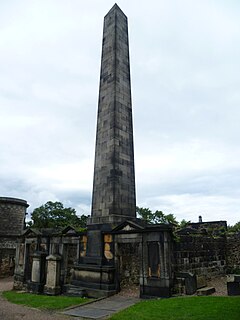
The Political Martyrs Monument, located in the Old Calton Burial Ground on Calton Hill, Edinburgh, commemorates five political reformists from the late 18th and early 19th centuries. Designed by Thomas Hamilton and erected in 1844, it is a 90 ft (27 m) tall obelisk on a square-plan base plinth, all constructed in ashlar sandstone blocks. As part of the Burial Ground it is Category A listed.
William Dingwall Fordyce was a Scottish Liberal politician. He was elected MP in 1866 to represent Aberdeenshire and, following the reorganisation of constituencies by the Representation of the People (Scotland) Act 1868, on 20 November 1868 to represent East Aberdeenshire.

Kincardine Castle is a Victorian country house in Royal Deeside, Scotland. Formerly known as Kincardine House, it is a private home of Andrew Bradford and also operates as a hospitality venue. The house sits 1 kilometre (0.62 mi) north-east of the village of Kincardine O'Neil, and 8 kilometres (5.0 mi) east of Aboyne on the north side of the River Dee, Aberdeenshire.

Castle Forbes is a 19th-century country house in the Scottish baronial architecture style near Alford in Aberdeenshire, Scotland.
Preston Hall, or Prestonhall, is a late-18th-century mansion in Midlothian, to the south of Edinburgh, Scotland. It is located 1.5 kilometres (0.93 mi) north of Pathhead on the east side of the Tyne Water, opposite Oxenfoord Castle on the west side. The house, together with several estate buildings, are the work of architect Robert Mitchell, and are protected as Category A listed buildings, the highest level of protection for a historic building in Scotland.
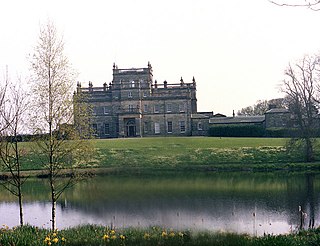
Kinmount House is a 19th-century country house in the parish of Cummertrees in the historic county of Dumfriesshire in Dumfries and Galloway region, Scotland. It is located 3+1⁄2 miles (5.6 km) west of Annan. The house was designed by Sir Robert Smirke for the 6th Marquess of Queensberry and completed in 1820. It is protected as a category A listed building, and the grounds are included on the Inventory of Gardens and Designed Landscapes in Scotland.
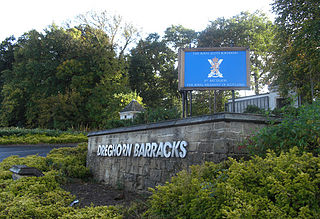
Dreghorn Barracks are located in Edinburgh, Scotland. The barracks are situated at the southern edge of the city, south of Colinton, and adjacent to the Edinburgh City Bypass.

Midmar Castle is a 16th-century castle in Aberdeenshire, Scotland, located 12 kilometres (7.5 mi) west of Westhill and 3.5 kilometres (2.2 mi) west of Echt. The castle was built for George Gordon of Midmar and Abergeldie between 1565 and 1575, and was constructed by the stonemason and architect George Bell. The castle is protected as a category A listed building.

Tarbat House is a Category A listed building in the Highland council area of northern Scotland. A three-story stone mansion in the neoclassical style, it was built in 1787 by the Edinburgh architect James McLeran for John Mackenzie, Lord MacLeod. The house is located approximately 500m from the village of Milton near Invergordon.

Udny Parish Church is a congregation of the Church of Scotland at Udny Green, Aberdeenshire in the north-east of Scotland, some 15 miles north of Aberdeen. Formerly known as Christ's Kirk, it was designed by the City of Aberdeen architect John Smith in 1821. Sited on the north edge of the village green, it is within the ancient Udny Parish and the Formartine committee area. It is a Category B listed building.
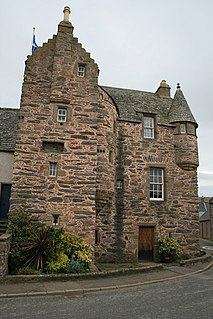
Fordyce Castle is a T-plan castle, its oldest part dating from 1592, about three miles south-west of Portsoy, in the village of Fordyce, Aberdeenshire, Scotland.

Mortlach Parish Church is a church within the Church of Scotland serving the parish of Mortlach, in Moray, close to the village of Dufftown. The site of the church has long been associated with Christianity, going back perhaps as far as 566 when St Moluag is said to have founded a religious community there. A Class II Pictish stone, dating from between the seventh and ninth centuries, was discovered there, which can now be seen in the burial ground. There was a bishopric on the site in the eleventh and twelfth centuries, prior to it being moved to Aberdeen in the reign of King David I. The current church retains some of the fabric of a thirteenth-century structure, which has been repeatedly remodelled in the centuries that followed, most recently in 1931. The church, along with the surrounding burial ground and a watch house within the grounds, has been designated a Category A listed building.
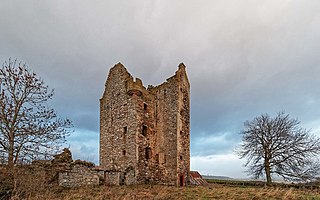
Fairburn Tower is a ruined Scottish castle near Inverness and the Muir of Ord in the parish of Urray.
References
- 1 2 3 Historic Environment Scotland. "Brucklay Castle (Category C Listed Building) (LB49988)" . Retrieved 26 March 2019.
- 1 2 "Brucklay House". Dictionary of Scottish Architects. Retrieved 16 March 2017.
- ↑ "Brucklay Castle". Buildings at Risk Register for Scotland. Historic Environment Scotland. Retrieved 16 March 2017.
- ↑ Historic Environment Scotland. "Brucklay Castle, Private Burial Ground with Obelisk (Category C Listed Building) (LB49990)" . Retrieved 26 March 2019.